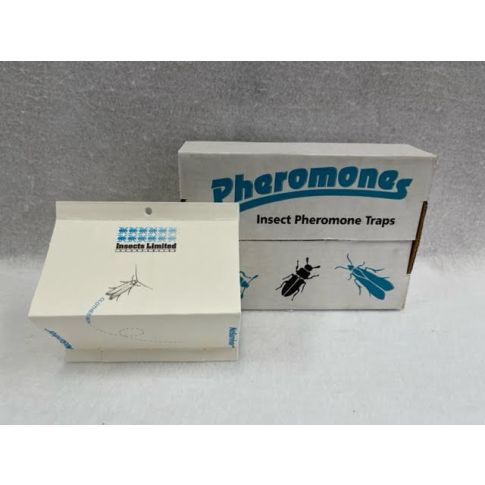Be the first to review this product
INSECTS LIMITED CASEMAKING CLOTHES MOTH KIT 10/CTN
| Size | 10 / PKG |
| Manufacturer | INSECTS LIMITED [view products, website] |
| EPA# | N / A |
| Label | None Required |
| SDS | il-220-10_casemaking_clothes_moth_sds_08012019.pdf |
| Use | Indoors |
| Not For Sale To | NOT FOR SALE IN: AK, HI, PR, NON U S LOCATIONS |
Utilizing pheromone traps is an effective tool for monitoring stored product pests, especially moths, such as Indian Meal Moths and Mediterranean Flour Moths. Pheromone traps are often used in food warehouses and food processing facilities.
For best effectiveness, place traps in a grid pattern to pinpoint new infestations. If vertical support beams are present, use them to set a grid pattern. Many warehouses have 40-foot by 60-foot bays established by their vertical supports. Some warehouses do not have vertical support beams, and in these cases, the pallet racking or other means can be used to secure a natural grid for a pheromone trapping program. Many warehouses have fire extinguishers set evenly around the warehouse that will offer a site for a trap. The size of the grid will vary with the type of trap and the facility, but as a general rule, intervals of about every 50 feet produce good results. If an area seems to have an infestation, more traps should be placed around that location to help zero-in on the infested goods.
Traps should also be placed near potential insect harborages, such as corners, beams, and entry and exit points (e.g., corridors). As a rule, traps for flying insects should be placed at a height of about 6 feet. Avoid placing traps near exterior doors and windows, as this could lure insects from outdoors.
The use of pheromone traps should not be limited to large food warehouses and food processing plants. They can be useful as well in smaller facilities such as restaurants, grocery stores, health food stores, pet stores, and even private homes. A few well-placed traps can be an early warning system to detect newly arrived infested goods and prevent wider infestations.
Utilizing pheromone traps is an effective tool for monitoring stored product pests, especially moths, such as Indian Meal Moths and Mediterranean Flour Moths. Pheromone traps are often used in food warehouses and food processing facilities.
For best effectiveness, place traps in a grid pattern to pinpoint new infestations. If vertical support beams are present, use them to set a grid pattern. Many warehouses have 40-foot by 60-foot bays established by their vertical supports. Some warehouses do not have vertical support beams, and in these cases, the pallet racking or other means can be used to secure a natural grid for a pheromone trapping program. Many warehouses have fire extinguishers set evenly around the warehouse that will offer a site for a trap. The size of the grid will vary with the type of trap and the facility, but as a general rule, intervals of about every 50 feet produce good results. If an area seems to have an infestation, more traps should be placed around that location to help zero-in on the infested goods.
Traps should also be placed near potential insect harborages, such as corners, beams, and entry and exit points (e.g., corridors). As a rule, traps for flying insects should be placed at a height of about 6 feet. Avoid placing traps near exterior doors and windows, as this could lure insects from outdoors.
The use of pheromone traps should not be limited to large food warehouses and food processing plants. They can be useful as well in smaller facilities such as restaurants, grocery stores, health food stores, pet stores, and even private homes. A few well-placed traps can be an early warning system to detect newly arrived infested goods and prevent wider infestations.

